The Colours Of India Can’t Wait To Intrigue Your Wanderlust!

Mention INDIA and you get this picture of vivid hues painted in your mind. No matter where you go across this fascinating country, it’s impossible not to witness the glory of colours. There’s meaning and soul behind the reds, blues, and yellows that you see in the charming ordinariness of everyday, satiating culture and culinary, off-the-cuff people, unfading traditions, random art on the streets, and the super vibrant festivities.
As a photo enthusiast, I always look for colours. I believe nothing can tell stories of a place better than its colours. For me, colours of India are experiences. Sometimes they just greet you, while sometimes they make you stop for a deeper rendezvous; sometimes they stupefy your senses and hook you on to play with your curiosity.
Also read: 6 Reasons Why Travel Photography Is An Epic Experience In India
Well, there are two purposes of writing this post – one, to celebrate India’s diversity through a new perspective; two, to give you guys more reasons to explore India. While we talk about changing landscapes and dialects in every 200 kms in India, there’s a common thread of colours that put all pieces together.
So, let’s dive deep into the amalgamation of hues of India!
The Colours Of India Can’t Wait To Intrigue Your Wanderlust – A Photo Essay
The traditions that never grow old.
The most beautiful aspect about the traditions of India is that you can spot them anywhere, any day and at any time. You have easy access to traditions in India in some way or the other – the cultural dances, the rituals, the street processions, or the weddings. I believe traditions are meant to uplift our spirits, give us joy, and a quick escape from our mundane lives.
“India has many customs and rituals that may seem bizarre to anyone not used to its distinctive culture. It is a strange combination of being a young nation as well as an ancient country.” – Hanadi Falki
Dharohar Dance Show at Bagore ki Haveli: It’s one of the top experiences of Udaipur. Colours are an integral part of the cultural dance performances of Rajasthan. Besides the haunting music and the stories, the dazzling outfits of the dancers instigate a kind of aweinspiring feeling within the viewers.
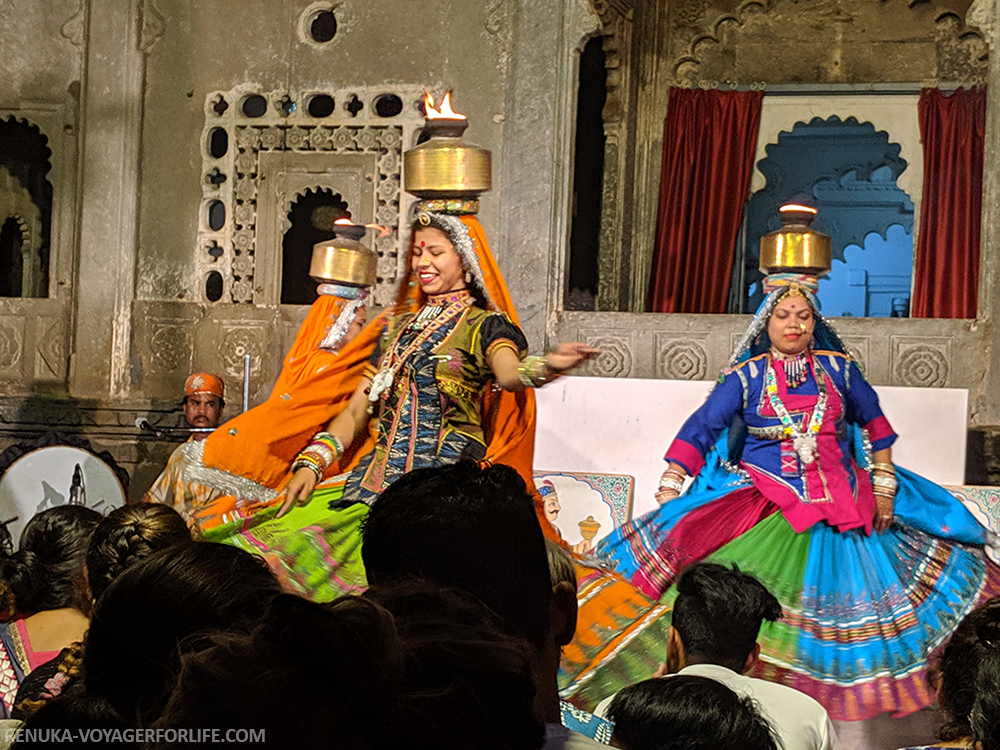
A puja basket of flowers and bananas at a temple in Tamil Nadu: Colours add their own beauty to the lively atmosphere around the temples in India. The flower baskets decorated for visitors to pick up for prayer offerings exude their distinctive appeal.
Also read: 10 Most Photographable Places In India
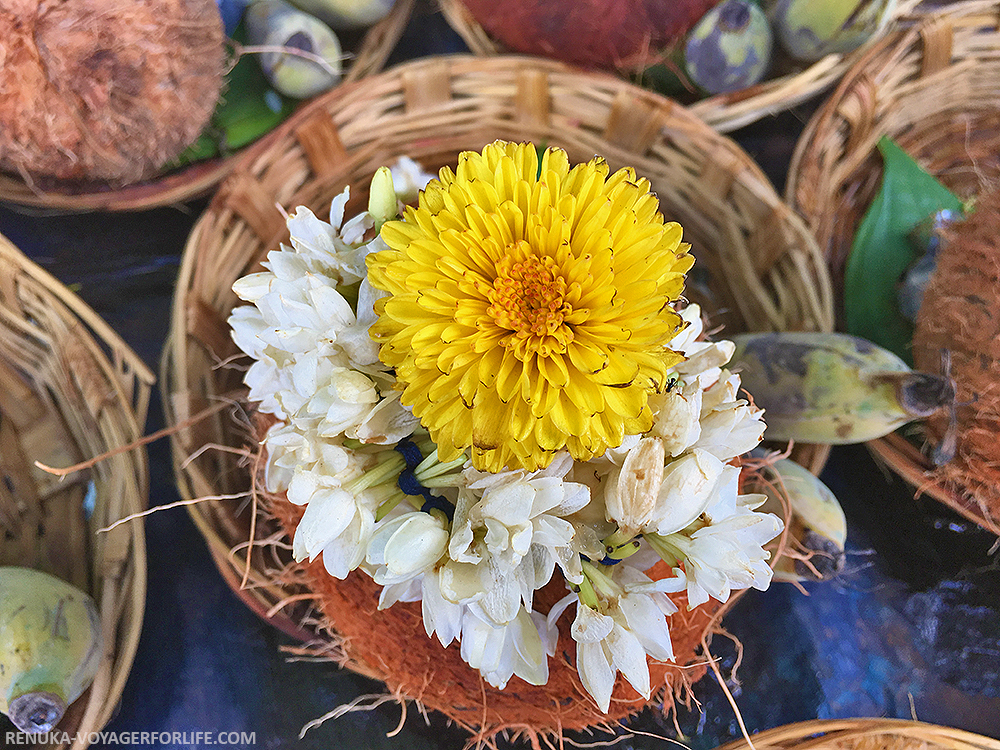
Rumtek monastery, Sikkim: It’s when the monks get ready for their prayer ceremony every day at the monastery. It’s a sight to watch them help each other with their attires. The evocative walls of a monastery, the mysterious murals and deities painted all over, speak volumes.
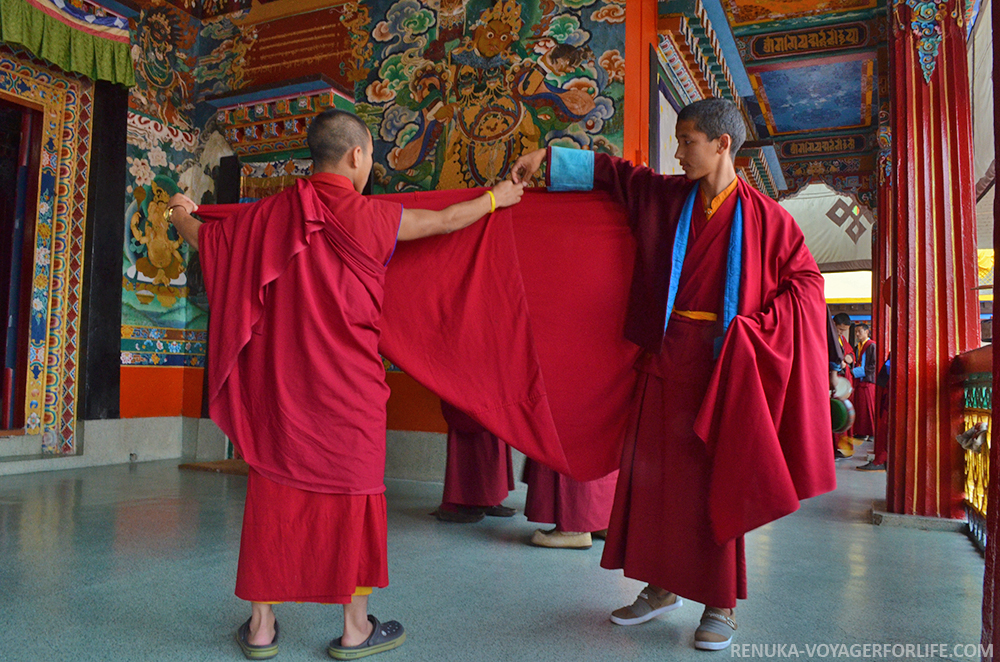
Yakshagana, a theatre dance form of the Northern Karnataka: It’s one of the most intense performances that one could watch live. The main dancer’s facial expressions, his movements to his costumes, everything contributes towards a powerful show.
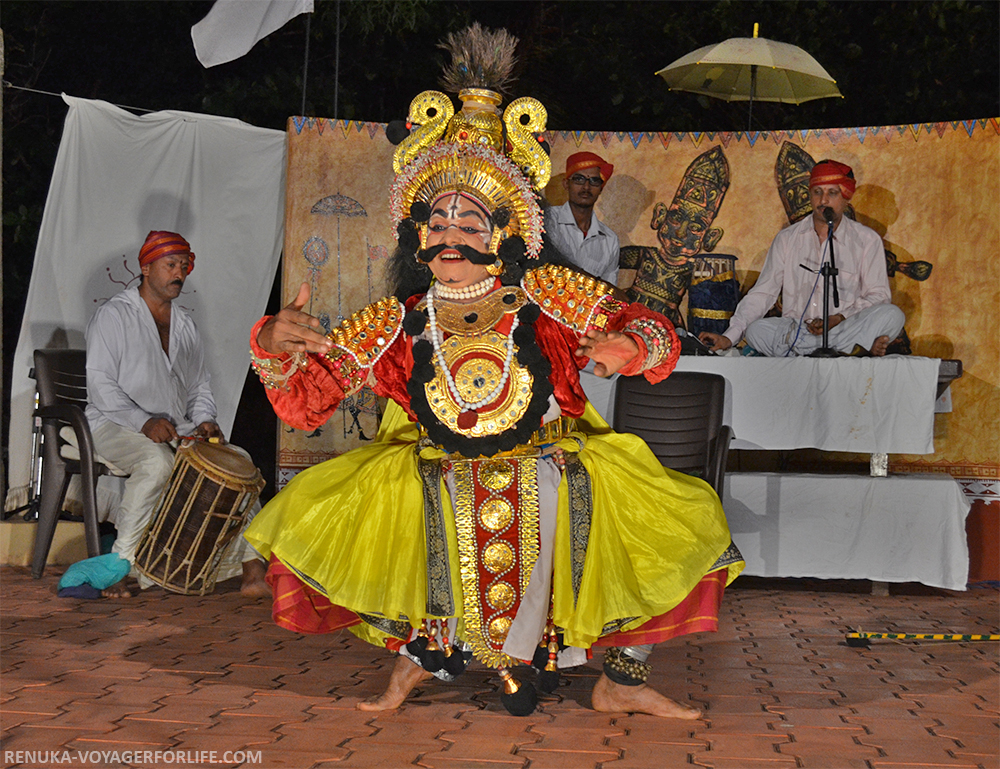
Dhimsa, a traditional dance of Arukku Valley (Andhra Pradesh): I got to witness this beautiful tribal dance just out of the blue! It was the occasion of a wedding and these prettily dressed women danced on the streets. Each one of them had uniformly adorned themselves with blue saris with pink borders, and gorgeous pink festoons of flowers in their buns.
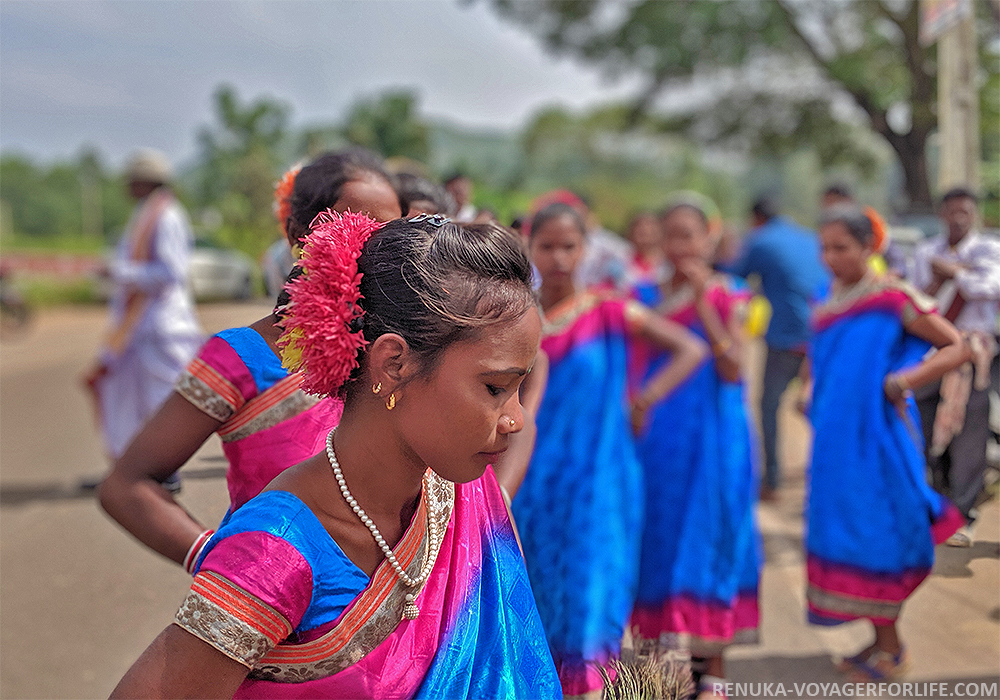
Kathakali dance, Fort Kochi (Kerala): It was interesting to watch the artists do their makeup on stage before the show began. It’s such an elaborate and long process. The colours used for eye, lip and their overall facial makeup have different meanings to them – green symbolises godliness, white reflects spirituality, red suggests turmoil, and black means evil.
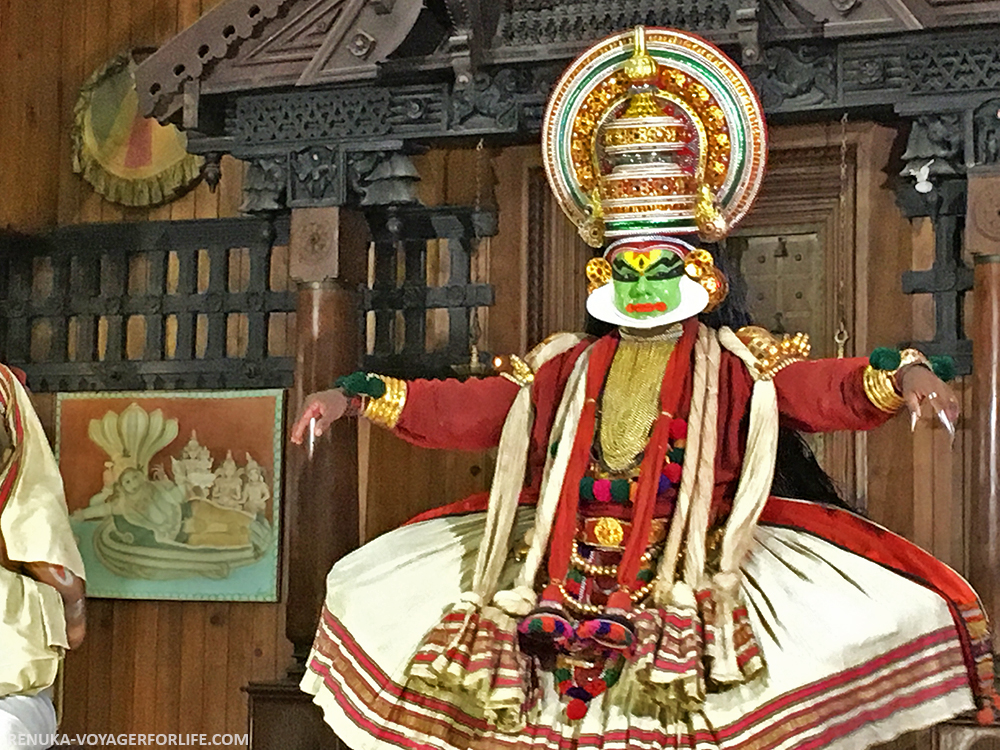
The beautiful shops and markets.
India’s love for aesthetics and colours is quite boldly depicted in the various shops and markets – local art & craft shops, paintings, bangle markets, emporiums and all sorts of knick-knacks. Sometimes it’s an overwhelming visual treat to witness spurts of creativity at just one small shop. And, here we have innumerable galleries to challenge our imagination.
As a traveller, I find it absolutely thrilling to visit shops and lanes that have vivid displays of products.
Bhujodi village, Kutch: It’s a unique village of weavers, block printers and tie-dye artists. Each home has art and tradition embedded in its walls. There’s so much to see and grasp. A ramble through Bhujodi is like slipping into a world of various hues and their stories.
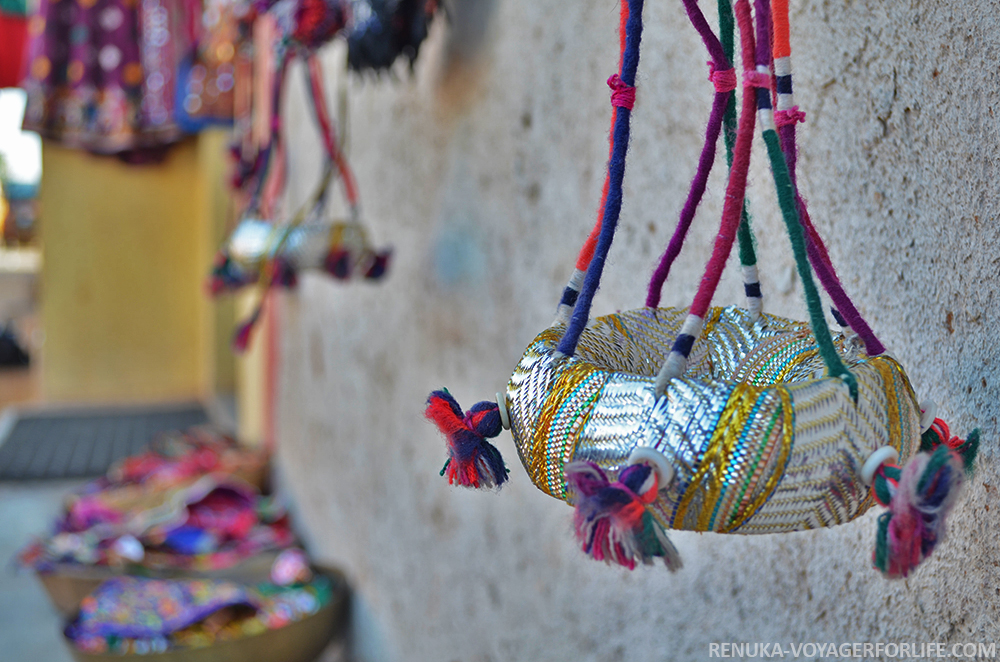 Laad Bazaar, Charminar (Hyderabad): Perhaps one of the most celebrated bangle markets in India is in old Hyderabad in Charminar. It’s primarily known for the legacy the Nizams left – pearls. However, there’s a short and sweet story behind the bangles, which a shop keeper, quite earnestly, narrated to me – “Laad Bazaar got its name when a king wanted to gift his beloved (Lado) daughter, bangles.”
Laad Bazaar, Charminar (Hyderabad): Perhaps one of the most celebrated bangle markets in India is in old Hyderabad in Charminar. It’s primarily known for the legacy the Nizams left – pearls. However, there’s a short and sweet story behind the bangles, which a shop keeper, quite earnestly, narrated to me – “Laad Bazaar got its name when a king wanted to gift his beloved (Lado) daughter, bangles.”
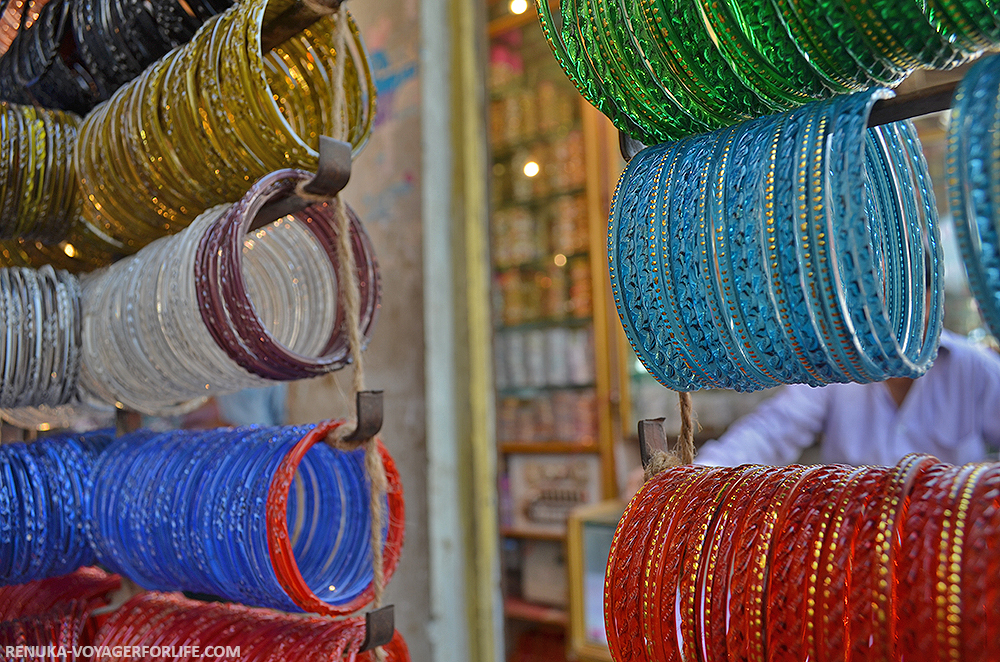 The narrow lanes of Golden Fort, Jaisalmer: It’s one of those places that mesmerize you pronto. The fort is called ‘Golden’ or ‘Sonar’ Quila because of the sun rays that bathe the fort walls and make them look golden yellow.
The narrow lanes of Golden Fort, Jaisalmer: It’s one of those places that mesmerize you pronto. The fort is called ‘Golden’ or ‘Sonar’ Quila because of the sun rays that bathe the fort walls and make them look golden yellow.
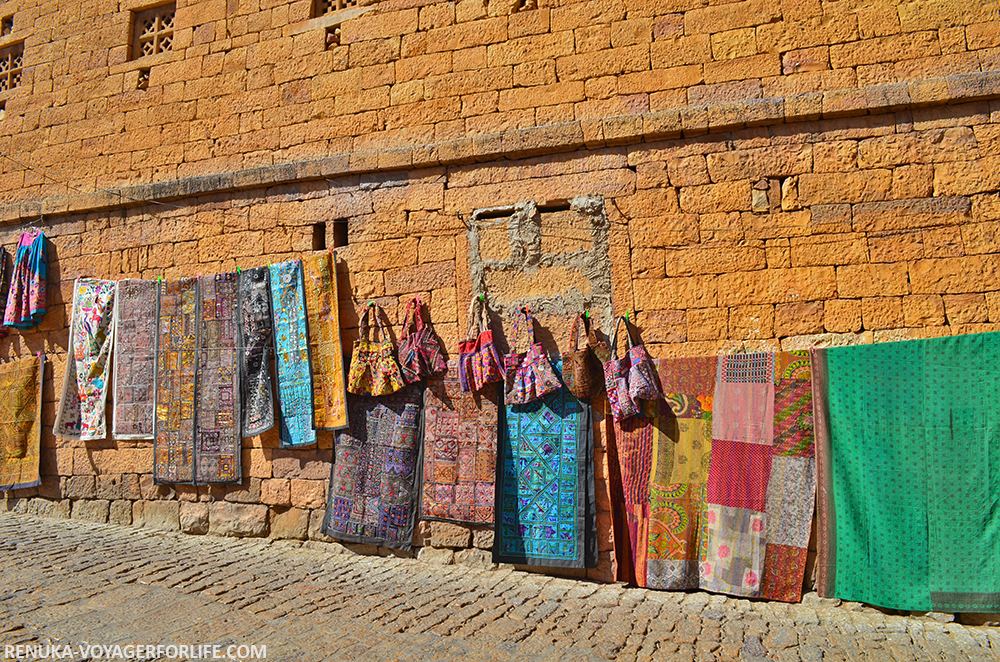
The fort has narrow alleyways, which has colourful shops and art galleries, cafes, hotels and houses. It’s a fascinating experience to get lost in the small lanes, admire the shops, the antiques, and everything that reflects Rajasthan’s heritage.
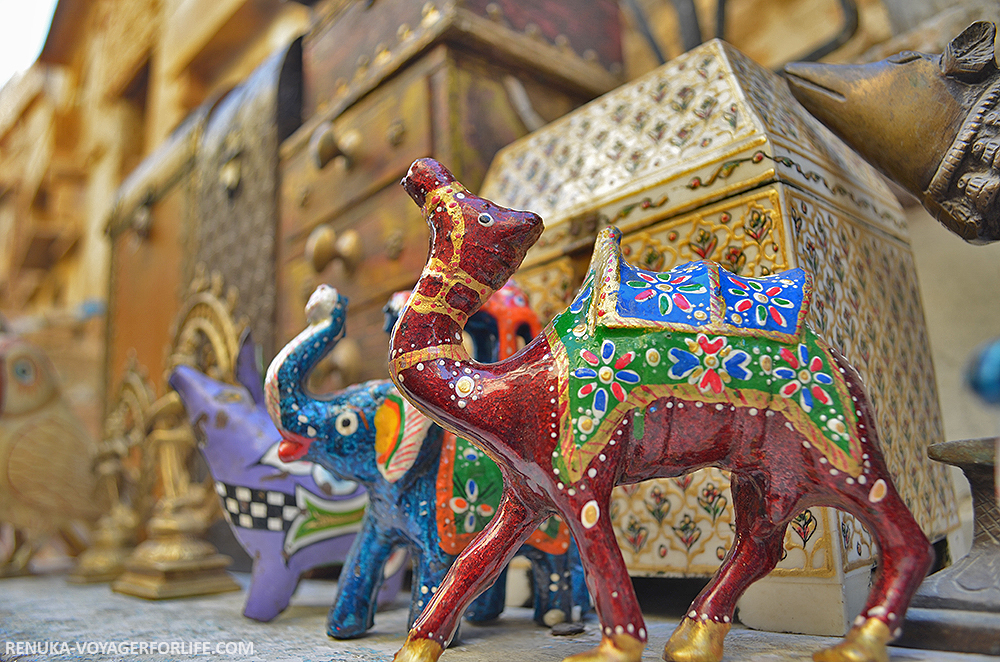 The heritage village called Raghurajpur, Odisha: It’s the most artistic village one could ever visit in India – known primarily for Pattachitra, a form of painting that dates back to 5th BC. Each village home has art on their walls, the verandahs have displays of traditional knick-knacks, and there’s also an array of temples to add to the magic.
The heritage village called Raghurajpur, Odisha: It’s the most artistic village one could ever visit in India – known primarily for Pattachitra, a form of painting that dates back to 5th BC. Each village home has art on their walls, the verandahs have displays of traditional knick-knacks, and there’s also an array of temples to add to the magic.
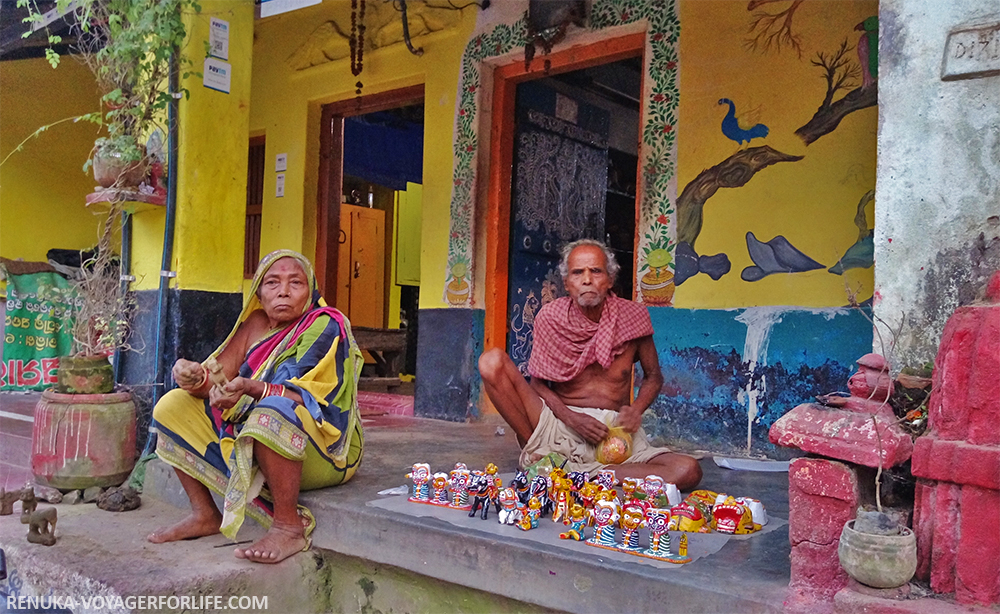
A flea market during the festival of Holi in Nagpur: The colours of Holi sprinkle happiness and cheer for all of us to enjoy. The festivals in India are grand and elaborate – the street markets are abuzz with activity, the stalls are adorned with all sorts of beautiful stuff, and there’s an obvious energy in the air.
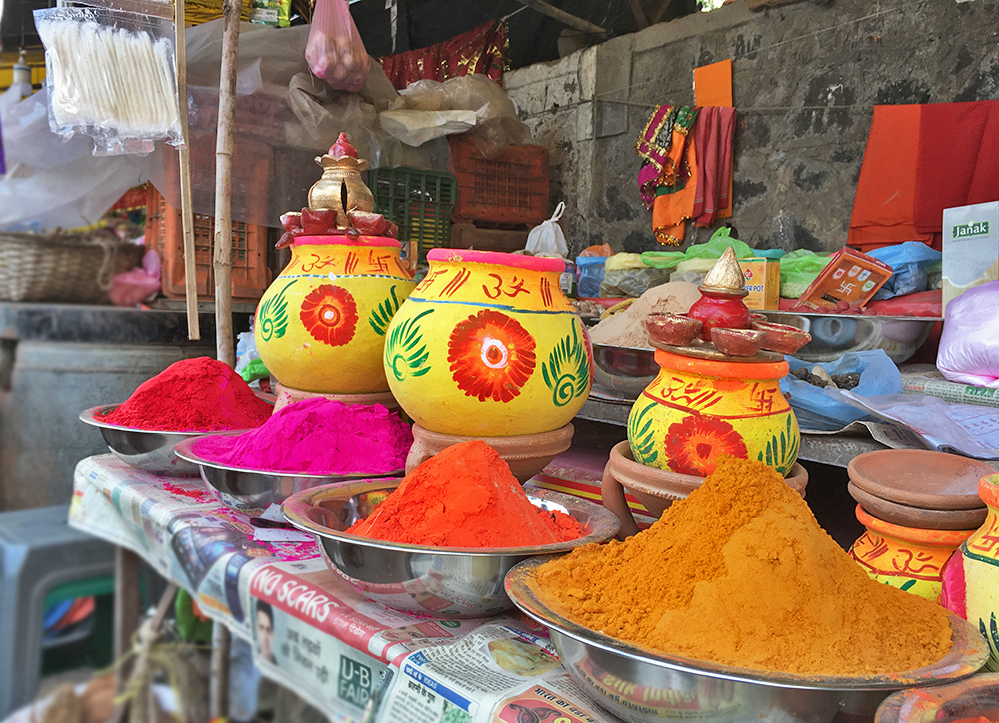 The evocative walls and doors of India.
The evocative walls and doors of India.
Well, the walls and doors of India, especially the rural India, know how to spellbind us. The folks in the villages have better taste when it comes to painting their houses and doors. They have an obvious love for colours, art and beauty. As a traveller, I find spotting doors and windows one of the most exhilarating experiences.
The village huts of Padavedu, Tamil Nadu: Padavedu is one of the most progressive and sustainable villages of South India – it’s home to school-going children, self-reliant women, and small businesses. And, it has pretty huts! I’m glad that they have retained their tradition of thatched roofs and colourful walls.
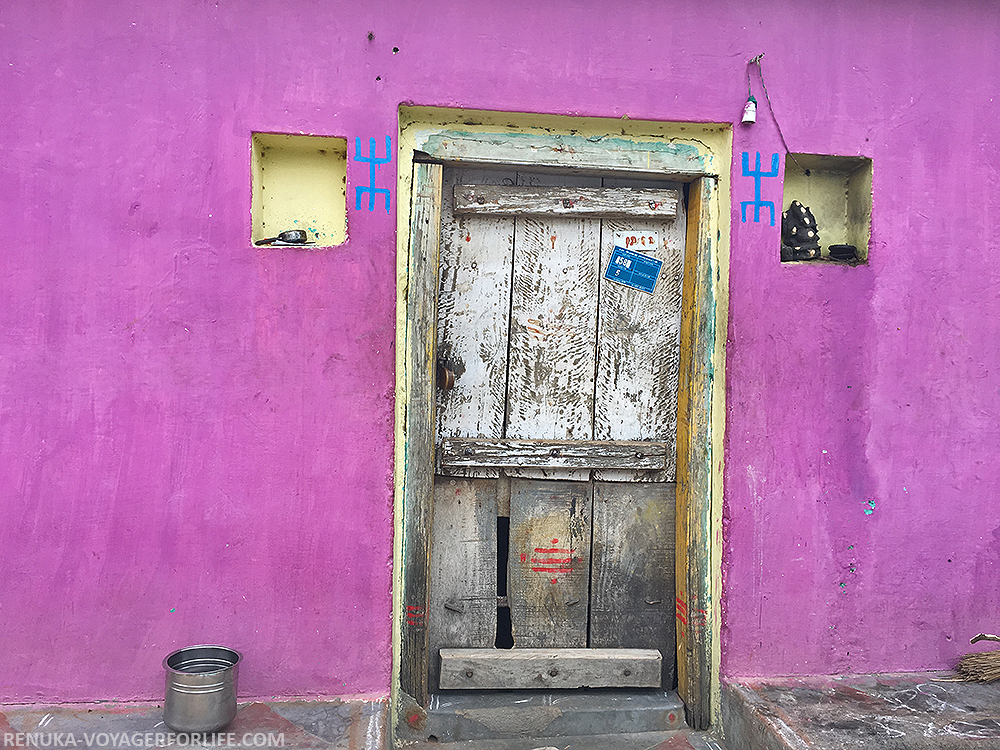
Blue-walled village houses of Dhamtari (Chhattisgarh): Dhamtari is a really small and unimposing town close to the capital, Raipur. One of the attractions of Dhamtari and the villages around is the use of the colour blue, which is like a stroke of art in the otherwise not-so-impressive surroundings.
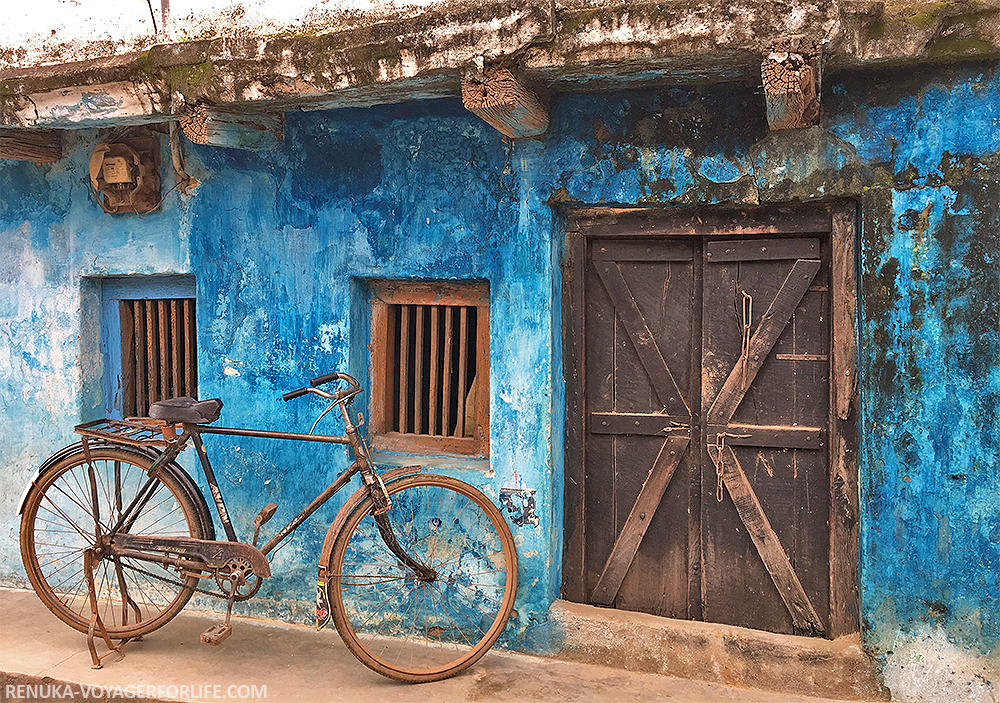
A typical village house in Kumaon (Uttarakhand): The traditional village homes of Kumaon are distinctively vivid. The two-storey houses have the basement as the space for cattle. The doors and windows of these houses are usually quite overt blues or greens.
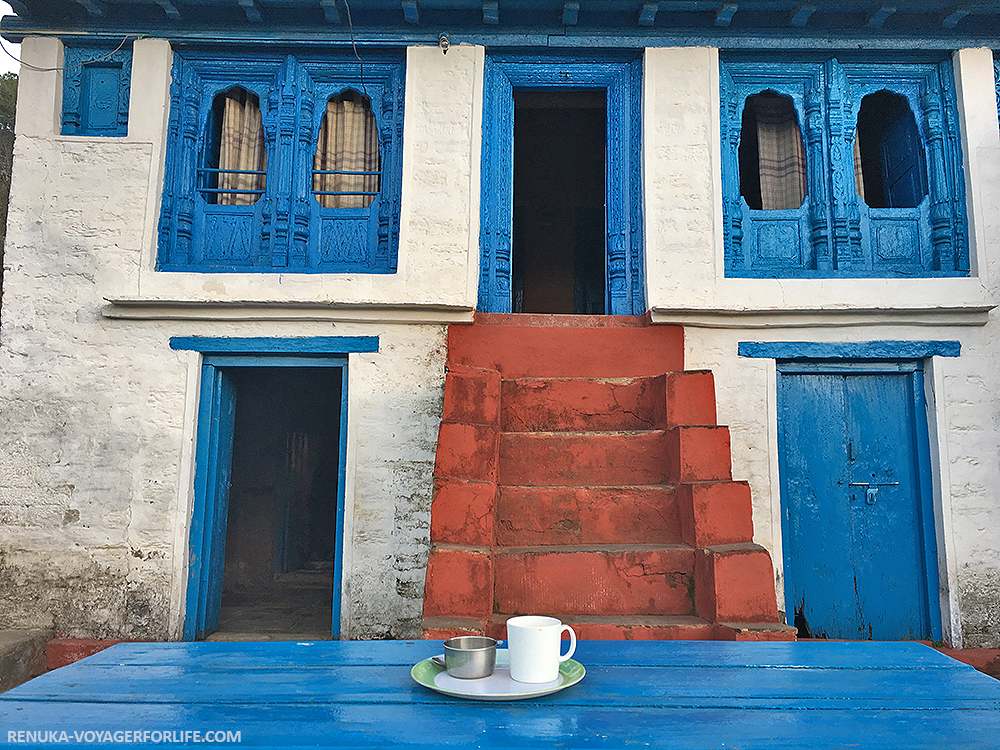
The Portuguese legacy of pretty houses in Goa: Even though Goa is primarily known for beaches and the wild lushness, there’s quite a lot for heritage enthusiasts. The ‘Portuguese’ Goa painted in its vintage appeal is exceedingly charming.
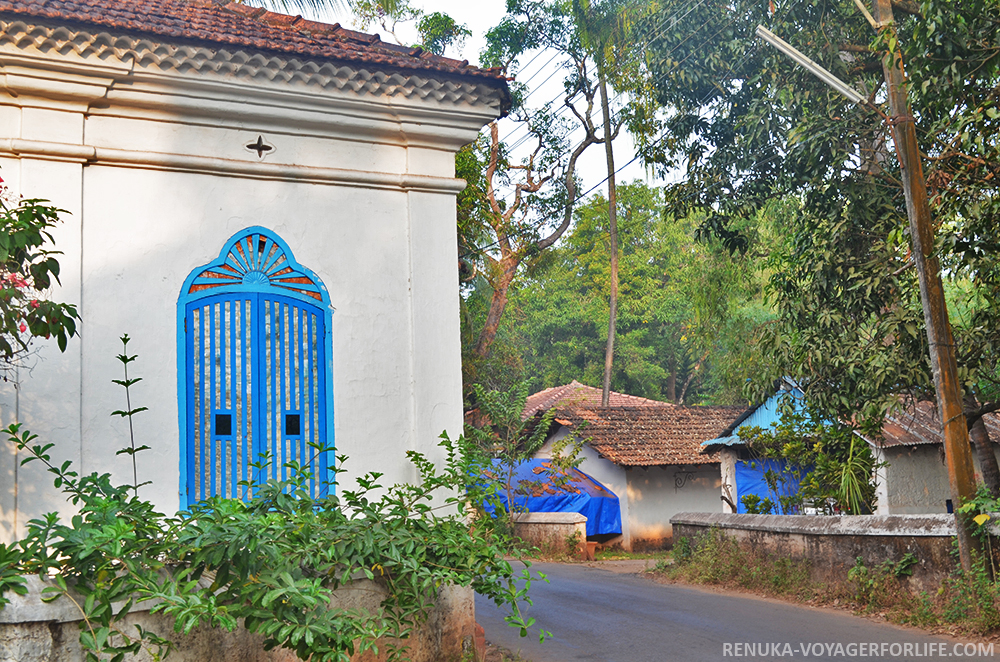
The old houses of Gwalior: Famed for its spectacular Gwalior Fort, the city is hugely underrated in terms of its historic appeal. The old temples, grand palaces and arrays of old houses and markets in Gwalior have their own charisma to exude. Yes, you will spot a lot of blue doors in Gwalior!
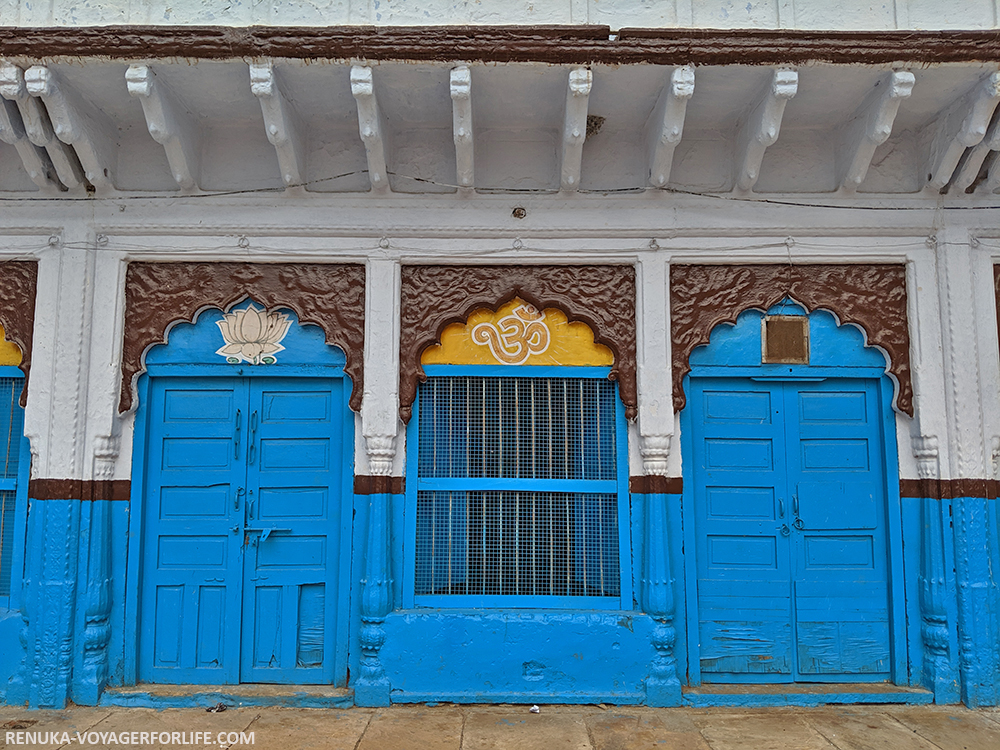
The charismatic temples and monasteries.
The ancient temples, mosques and monasteries of India have a certain mystic and enigma about them. The aura of such places is absolutely beguiling. The passion for colours is quite unabashedly seen in the architecture.
Kwan Kung Temple, Mazagaon (Mumbai): There’s a totally different side of Mumbai to see in Mazagaon. It’s known to be China Town, where you get to shake hands with a few Chinese remnants, such as a beautiful temple called Kwan Kung. The temple has excessive use of red in its design and architecture, as the colour is considered auspicious by the Chinese.
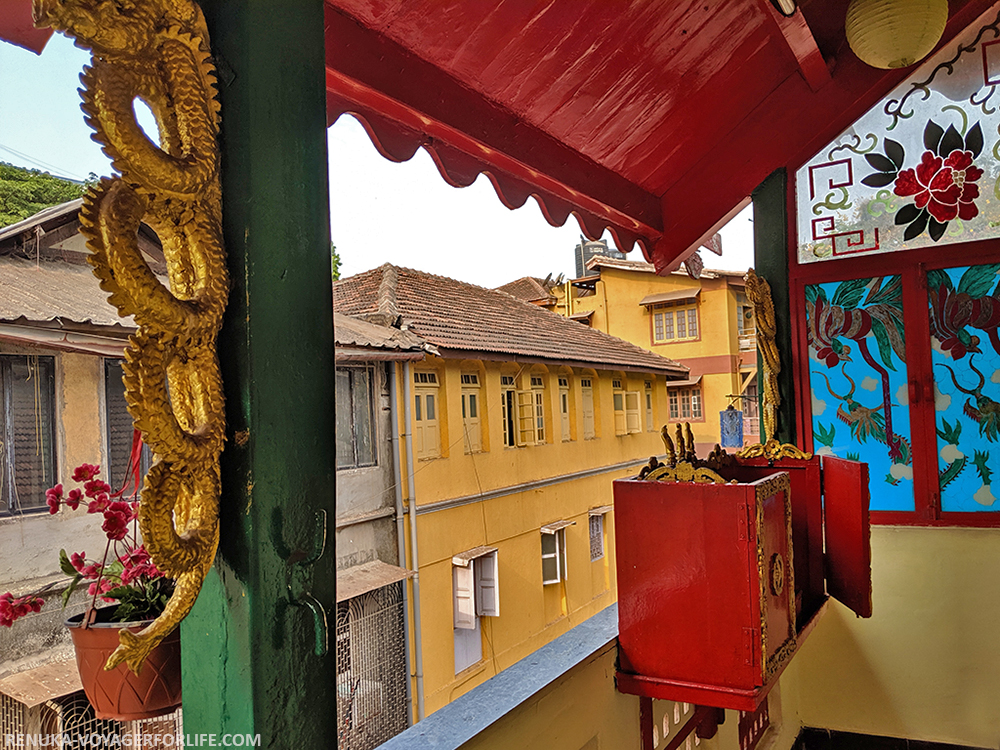
Naagridas Temple, Raipur: It’s a beautiful temple complex in Purani Basti (Old Colony) of Raipur. There are different colours and designs used in the courtyard and the windows. Raipur is one of the oldest and the rarest heritage cities of India.
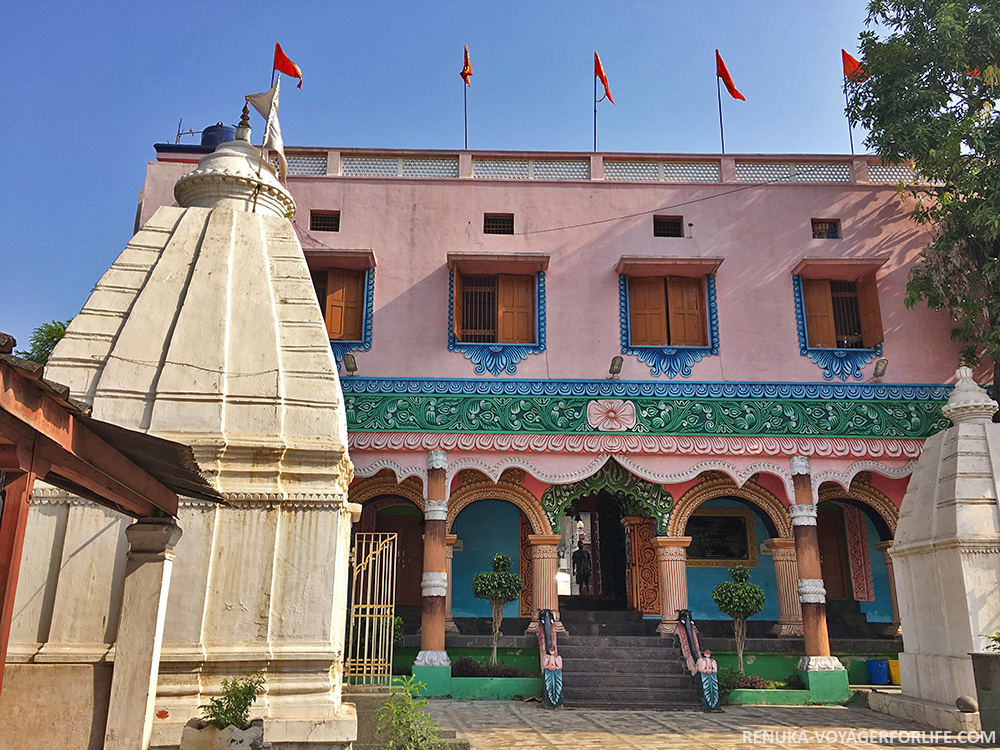
Dubdi monastery, Yuksom (Sikkim): It’s a 17th century, exceedingly gorgeous monastery on top of a hill in Yuksom. The dilapidated walls clearly depict the passage of time. Dubdi monastery is significant to the history of Sikkim, as it’s associated with the foundation of Sikkim; therefore, Yuksom was the original capital of the state.
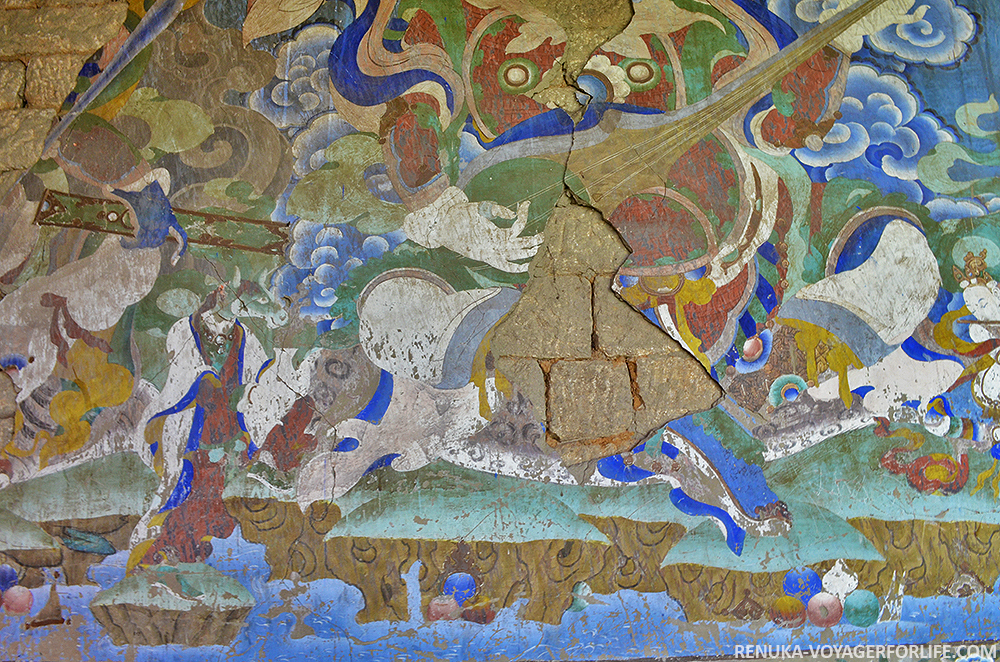
The compelling street art or graffiti.
India has plenty of street art to amaze us. Thankfully, the trend of graffiti or wall art is growing in India, which is a great promise for artists to showcase their work and create some cheer in our lives. I believe street art is meant to make you happy and also, aware of the things that are relevant.
The old lanes of Udaipur: The street art in any town of Rajasthan, especially Udaipur, is mostly about its regal heritage. It’s fascinating to amble through a narrow lane of walls painted with different stories of the royal era.
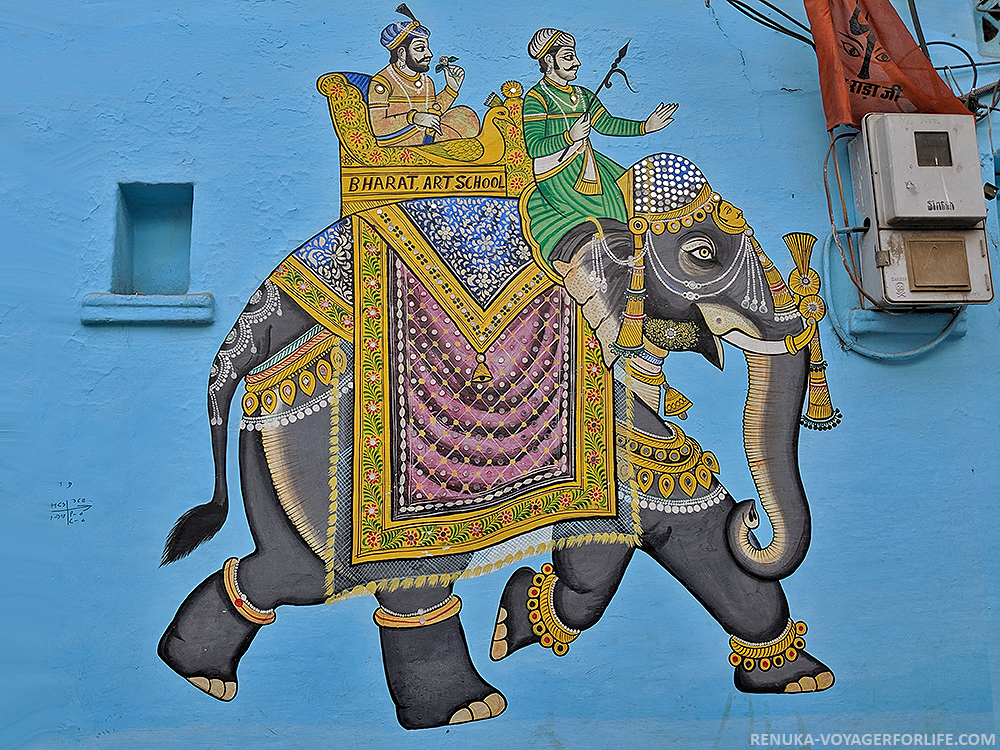
The cinematic art in Ranwar village, Bandra (Mumbai): Mumbai is incomplete without cinema, and vice versa. The walls of this charming village in Bandra are bedecked with the sketches of Bollywood legends, which makes you stop and take a look.
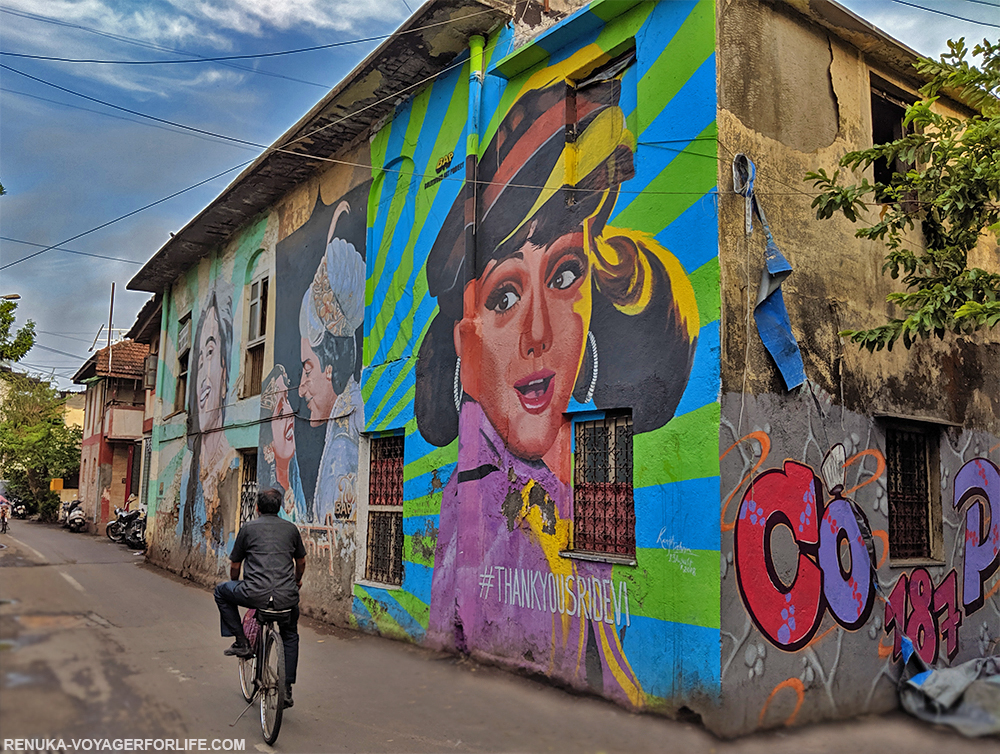
The quirky walls of Nagpur: Nagpur is one of the cities, which have contributed towards the trend of graffiti walls in India. The city has an easy vibe with glimpses of buoyant art on the streets.
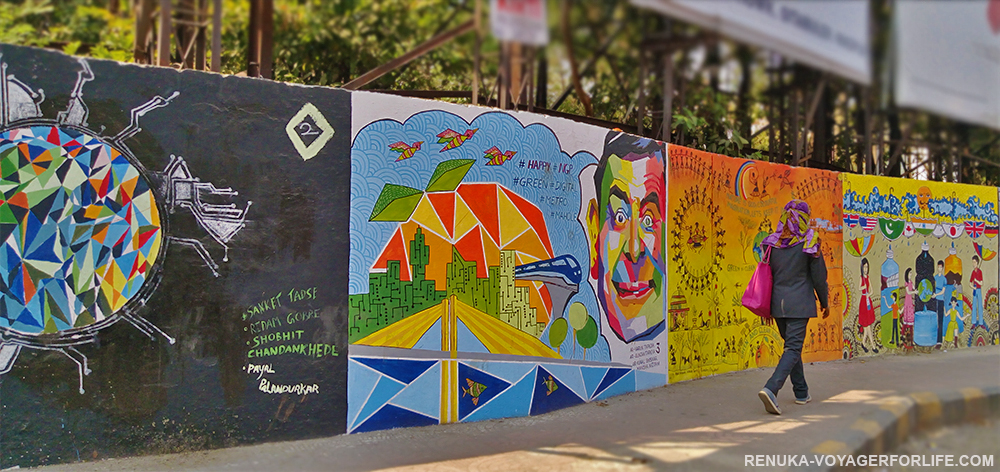 The unique local heritage.
The unique local heritage.
Sometimes the local heritage of a place is so ordinarily available for everyone to see that people forget to give it due attention or admiration. It’s usually the small things that are unique and speak about the traditions of a place.
The azulejos of Goa: The pretty azulejo sign-boards and name plaques of Goa speak about the magnificent Indo-Portuguese heritage of the state. Besides the ornamental appeal of the tiles, they also help with temperature control in buildings.
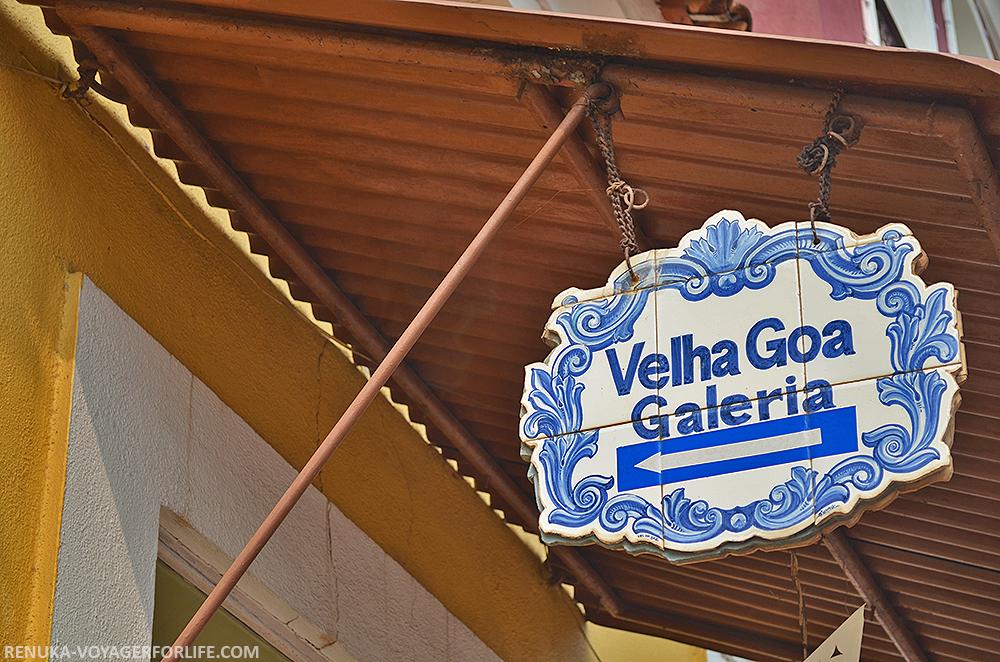
The prayer wheel of Northeastern regions: If you have been to any of the states of Northeast India, you must have seen the prayer wheels with mantras embossed on them. They are most commonly found in the premises of a monastery. However, you can even spot them on the doors and windows of homes.
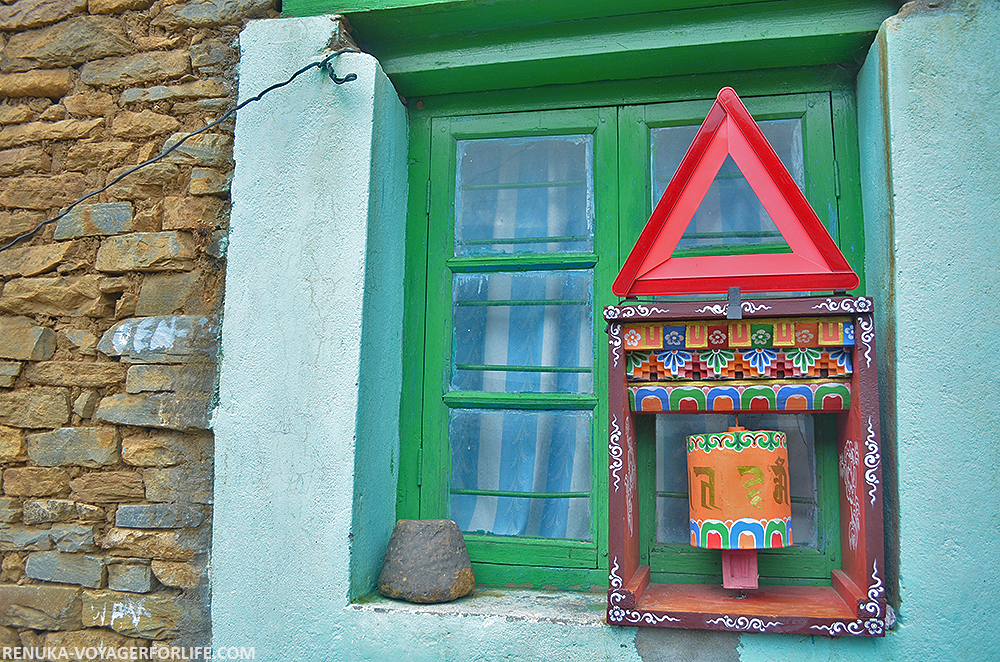
The shikaras of Kashmir: The most classic legacy of Kashmir are the shikaras, the beautiful wooden boats that float on Dal Lake and the other lakes in Srinagar. The calmness of the lake, the mountains, the comfort of reclining in a boat, and the regal feeling make the experience of a shikara ride exceptionally romantic.
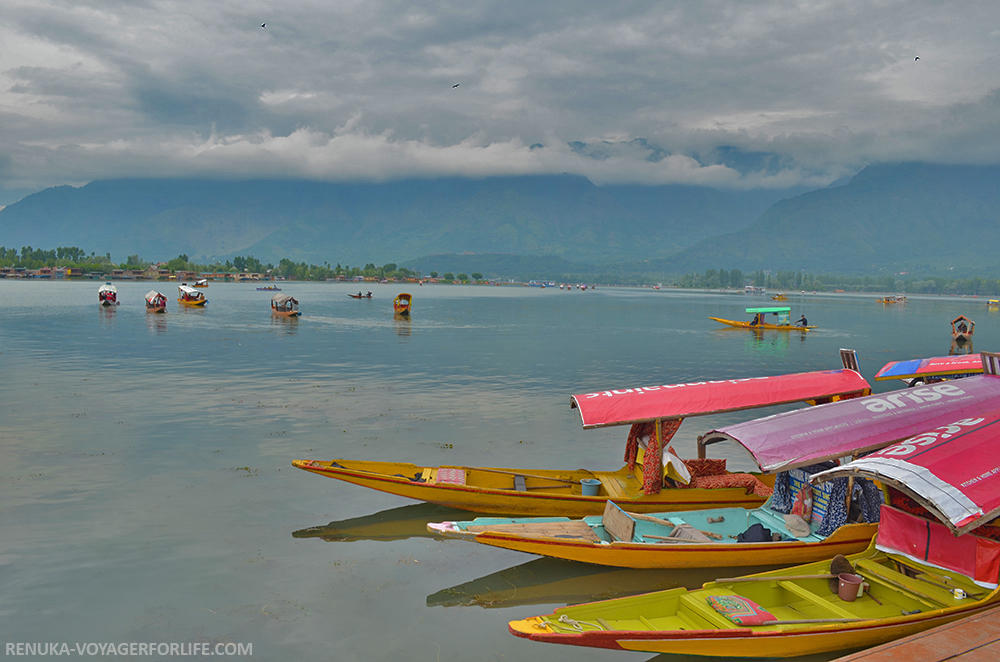 The eternal poetry of food.
The eternal poetry of food.
Food is like poetry in India. It’s weaved and celebrated on various levels. The true diversity of India comes alive through its cuisine. Each state and each region have their own individualistic culinary to boast about. The easiest way to immerse into the heart and soul of India is through your taste buds.
The allure of spices at Anjuna Flea Market, Goa: The spices play a pivotal role in the food journey of India. The most popular Indian spices, such as turmeric, ginger, cardamom, cinnamon, and clove are ancient. Spices entice all your senses – from your eyes to your tongue, with their colours, fragrances, textures and flavours.
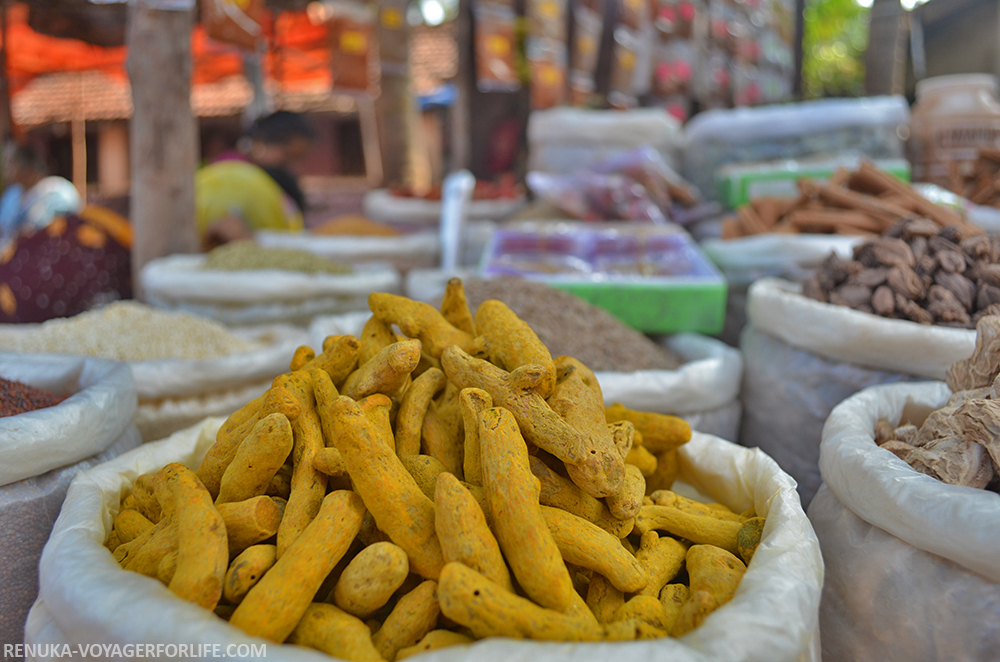
Weekly mart of the forest produce in Kasipatnam (Andhra Pradesh): The fresh vegetables, fruits and spices brought by the tribes of Vishakhapatnam stir a lot of emotions. It’s quite ironical how we savour the beautiful colours and fragrances of the produce in our oblivion of the agony that farmers have to go through.
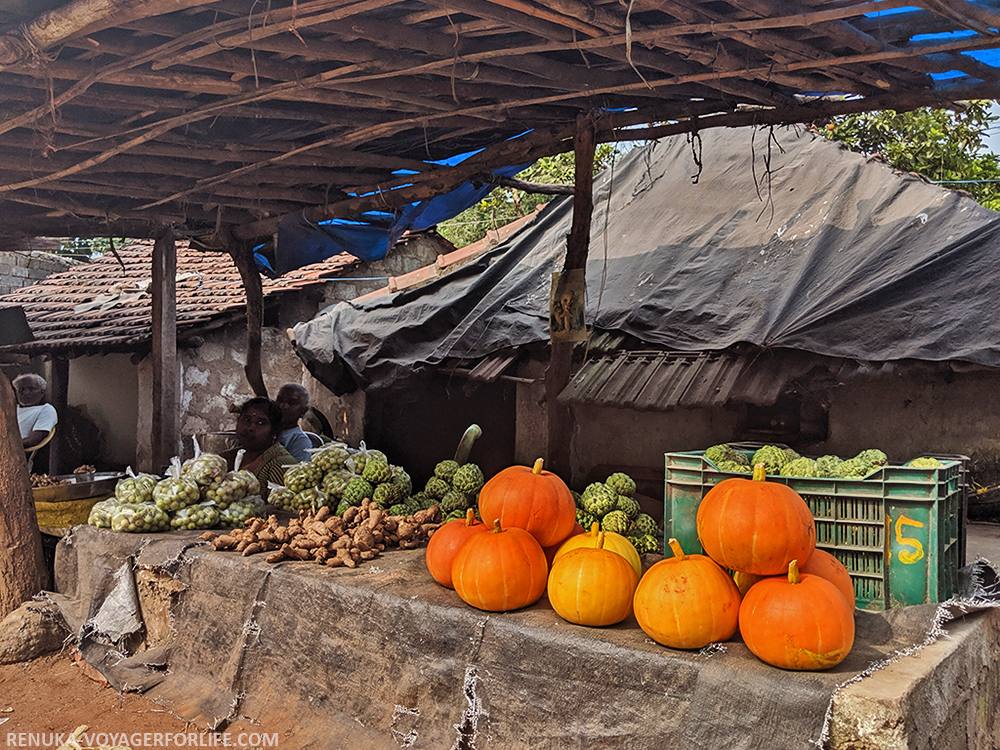
Bhut Jolokia, the red chilies of Arunachal Pradesh: Red chilies are the most gorgeous looking spices used in Indian cooking. There are various kinds of red chilies, but the one that really sizzles up your tongue is the one relished in the northeast India – Bhut Jolokia (ghost pepper), the super-hot chili!
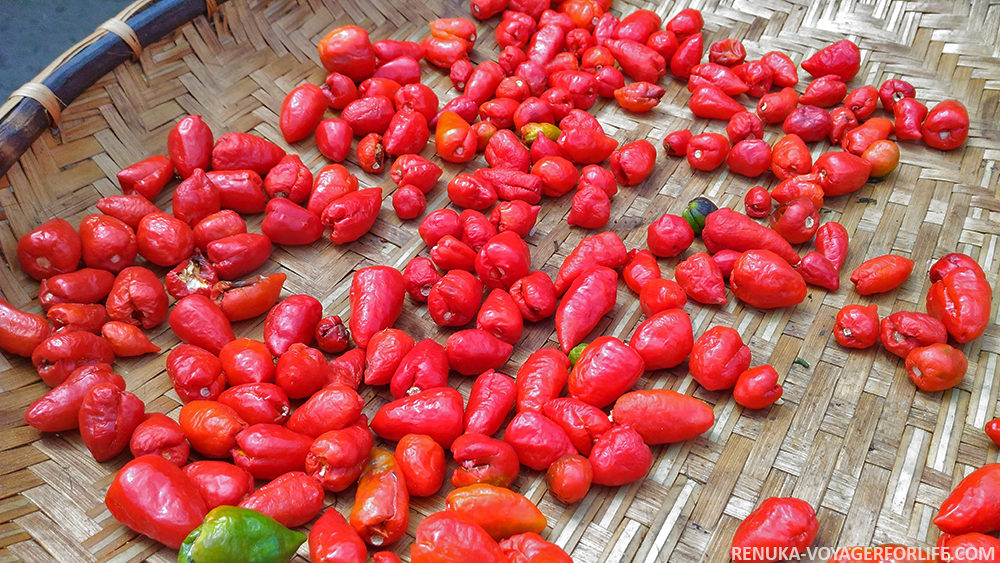
Corns of Dirang Valley (Arunachal Pradesh): The bloom of corns is such a happy sight! The corn fields spread across acres look so pretty. It’s usual for the villages of Arunachal Pradesh to grow corn, as it’s one of the main ingredients of their cuisine.
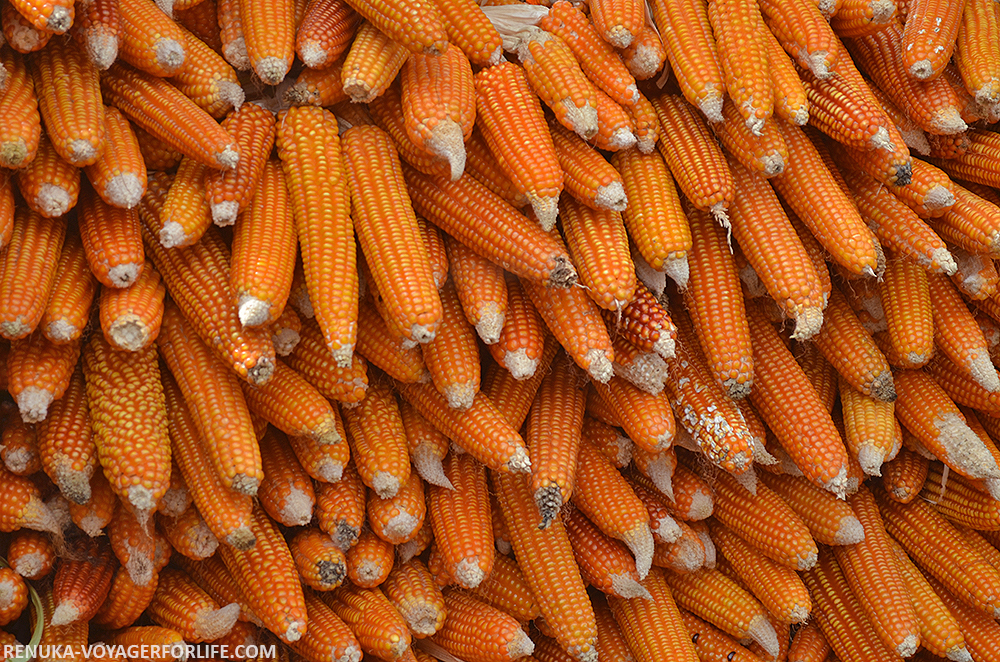
Saurashtra Mishthan Bhandar, Raipur: All the Indian sweets are pure romance – they don’t just tempt your taste-buds, but entice all your senses with their colours and aroma. Even the old sweet shops have their own charm. The halwais (confectioners) seem to be so engrossed in churning out the sweetness and unaware of the world around that it’s almost divine.
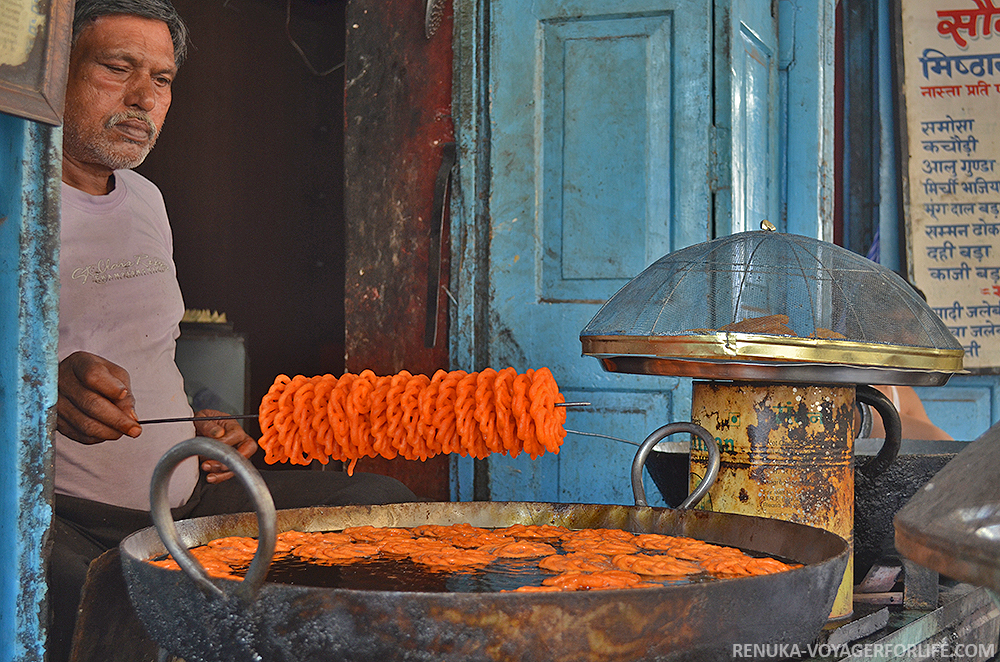 Beautiful people and their beautiful garbs.
Beautiful people and their beautiful garbs.
India has diverse regions, languages, cultures and communities. Thus, the style of dressing also varies across the country. Different people of different states have their own traditional attires. It’s amazing how people of all the communities look so beautiful when they are traditionally dressed.
Kumaoni ladies on the field, Nathuakhan: The village women of Kumaon wear a lot of pinks, blues and greens – their saris are usually quite striking. Their faces are adorned with smile, eyes with a certain spark, and these vivacious women are always keen to show their mangalsutra whenever they are photographed.
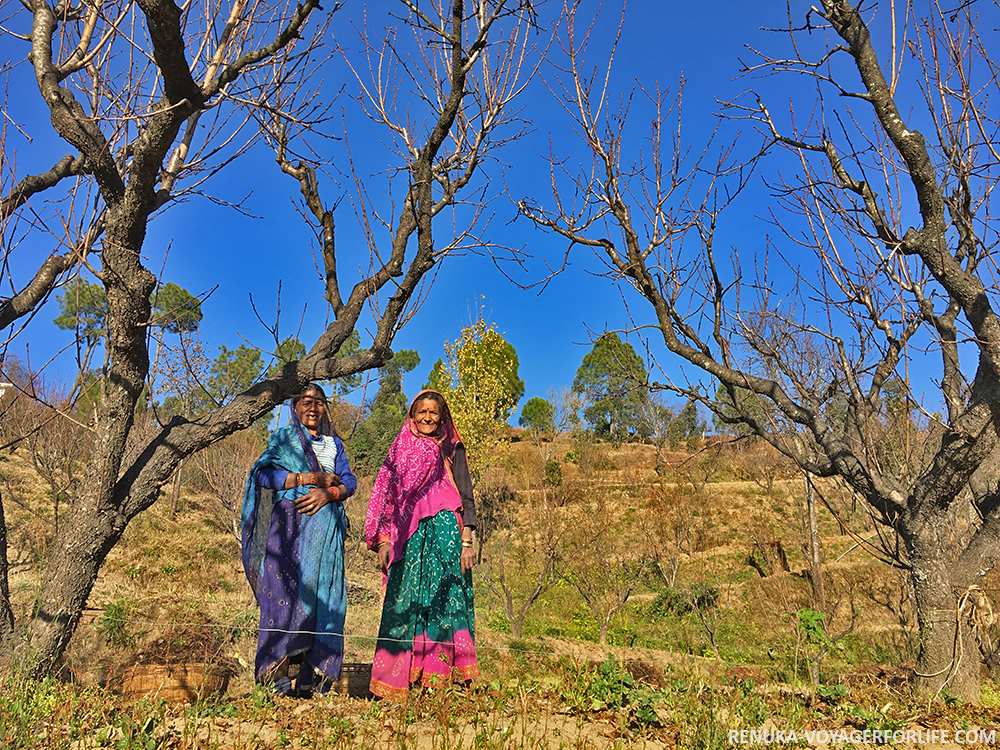
The bright red sari and the orange turban (Ajmer, Rajasthan): The street artists that you usually spot in Rajasthan are so splendidly garbed. The women are dressed in such bright pinks and reds with lovely ornaments, and the men are in turbans and dhotis.
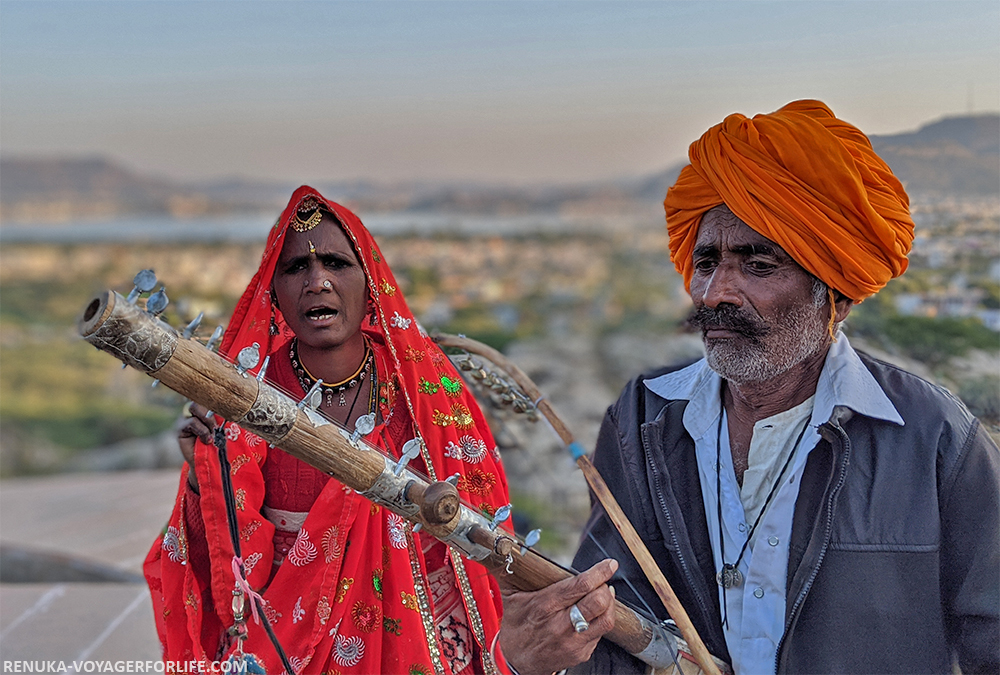
“Life is a Festival of colors.” ― Anthony T. Hincks
“Of all God’s gifts to the sighted man, color is holiest, the most divine, the most solemn.” – John Ruskin
Do you get fascinated by the colours of India?
Enjoyed this post? Subscribe to receive ‘new posts’ straight in your inbox!